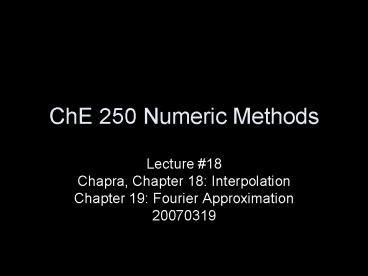ChE 250 Numeric Methods - PowerPoint PPT Presentation
Title:
ChE 250 Numeric Methods
Description:
It is often more convenient to use Lagrange Polynomials ... those closest to the desired value, and throw away the rest of the given points ... – PowerPoint PPT presentation
Number of Views:43
Avg rating:3.0/5.0
Title: ChE 250 Numeric Methods
1
ChE 250 Numeric Methods
- Lecture 18
- Chapra, Chapter 18 Interpolation
- Chapter 19 Fourier Approximation
- 20070319
2
Today
- Interpolation
- Lagrange Interpolating Polynomial
- Spline
- Fourier Approximation
- Least Squares
- Continuous Fourier series
- Time and Frequency domain
- Fast Fourier Transform
3
Lagrange Polynomials
- Calculating the finite differences required for
Newtons Interpolation can sometimes be
cumbersome - It is often more convenient to use Lagrange
Polynomials - These are calculated by a product of the
differences of the independent value for
surrounding data points
4
Lagrange Polynomials
- Terminology an nth order Lagrange Polynomial
requires n1 data points - The points used in the calculation should be
those closest to the desired value, and throw
away the rest of the given points - Several polynomials can be solved and the best
one chosen - An r2 can also be calculated
5
Lagrange Polynomials
- Equation The polynomials are Li which are
calculated using the Pi, product - Example 18.6
- Questions?
6
Lagrange Polynomials
- Which is the best fit?
- (a) 4th order
- (b) 3rd order
- (c) 2nd order
- (d) 1st order
Time, s Measured Velocity, cm/s
1 800
3 2310
5 3090
7 3940
13 4755
7
Lagrange Polynomials
- Summary
- Newtons polynomial may be better when attempting
to determine the order of the polynomial to use - Can calculate error easily
- Lagrange method is easier to implement when the
order of the polynomial fit is known - Both will have significant rounding error for
higher orders
8
Spline Interpolation
- Connect the dots method
- First order is exactly like a linear
interpolation - Second order (quadratic) matches the value and
the first derivative - Third order (cubic) matches value, first and
second derivative at each interior point, or knot
9
Spline Interpolation
- Cubic spline can be represented by a function in
each interval of the form - By setting the first derivatives at the interior
knots equal on adjacent cubics - And also the second derivatives
10
Spline Interpolation
- Now, we have to solve for all the as, bs, cs
and ds using some form of simultaneous solution,
or matrix solution for larger sets
11
Spline Interpolation
- For Scilab, The splin function with natural
argument returns the derivative vector - This can be used with the interp function to
interpolate a value
Example 18.10, Cubic Spline on Scilab
12
Spline Interpolation
- Splines have the distinct advantage of sitting a
dataset very well, no matter how discontinuous
the data is - Even if the data changes regimes
- Example 18.10
- Questions?
13
Fourier Approximation
- Polynomials fit many functions associated with
physical properties - But when functions of time are considered, they
are often periodic and not well-modeled by
polynomials
14
Fourier Approximation
- Polynomials fit many functions associated with
physical properties - But when functions of time are considered, they
are often periodic and not well-modeled by
polynomials
15
Fourier Approximation
- The Fourier series transforms a given periodic
function into a superposition of sine and cosine
waves - The following equations are used
16
Fourier Approximation
- For cases where the function is not known, but a
data set with points equally spaced in time is
available, the data can be fitted using a Fast
Fourier Transform - This is done routinely in electronic equipment
including laboratory analysis - e. g. spectroscopy
- FFT Example
- Questions?
17
(No Transcript)
18
Preparation for 16Mar
- Reading
- Chapter 19 Fourier Approximation
- Homework Due Friday
- Chapter 17
- 4, 7,9,12, 17,25,29
- Chapter 18
- 5, 7, 11, 13
- Chapter 19
- 4, 6, 12, 14, 22
- Chapter 20
- 12, 14, 17































